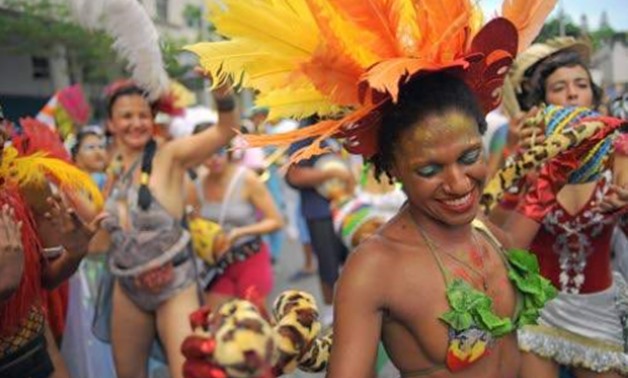
RIO DE JAMEIRO, Brail — Revellers take part in a “bloco” or street party in the run up to Rio's carnival, in Rio de Janeiro, Brazil on February 4, 2018 - AFP
RIO DE JANEIRO, Brazil — 8 February 2018: Imagine putting on the biggest show in town, pulling in hundreds of thousands of people, but still wondering if you'll be able to fund basic things like loudspeakers.
That's the odd situation facing Rio de Janeiro's informal carnival street parties called “blocos”, which take over the Brazilian city every year at this time and have grown far beyond their humble roots.
Although much less known abroad than the colourful, organised parades at the Sambodromo, the “blocos” are an equally important part of the carnival that turns Rio into the world's biggest party before the start of the Catholic period of Lent.
A total of 473 “blocos” will have danced their way through Rio de Janeiro's streets over January and February, some of them performing twice, so that the total number of parties is expected to hit 600.
Bands playing mainly samba music, costumes and drinking are the main constants.
But otherwise each “bloco” has its own identity, ranging from one for dogs in fancy dress to the mammoth Cordao da Bola Preta, which attracts more than a million revellers, scheduled for February 10.
To watch the extravaganza at the Sambodromo, you need to pay anything between 10 and 500 reais (US$3-US$155).
Want to go to a “bloco”? Just show up.
However, the fact that “blocos” don't charge for entry means these laid-back events are increasingly struggling to pay the simplest bills.
FRIENDS' GET-TOGETHER
Despite being annual fixtures — and, some would argue, the real soul of carnival season — “most 'blocos' began with no more than a group of friends”, said Tiago Rodrigues.
He's from a “bloco” called Orquestra Voadora, or Flying Orchestra, which launched in 2009 and now draws crowds of more than 100,000 to its parade.
“We were just 15 amateur musicians who played in various parades and we decided to create our own band,” Rodrigues said. “We've had crazy growth.”
Success, though, means ever higher costs, especially for sound systems and the extra security needed to deal with large crowds.
Organisers raise money mostly by taking their bands around the country for fee-paying concerts outside of carnival season. They also look for private sponsors, a goal that has become harder at a time of economic slump in Brazil.
“Everyone is a volunteer here. We share the tasks,” said Rodrigues, who estimates the costs at around 70,000 reais (US$21,700).
“Last year was the first time we didn't have to pay from our own pockets.”
Another popular “bloco”, Quizomba, which was started in 2001 by five friends, holds paying classes for drumming, with about 2,000 students so far, said director Andre Schmidt.
“People have no idea how the carnival is financed. We're the ones who take the party into the streets, but this year we won't have any sponsors,” said the founder of Multibloco, Thais Bezerra.
At the Terreirada Cearense “bloco”, Igor Conde said they had borrowed 13,000 reais (US$4,036) to cover last year's budget shortfall.
TOURISM BOOST
Carnival brings a splurge of spending on hotels, restaurants and other tourism staples in Rio. City hall says it expects about 3.5 billion reais (US$1.1 billion) this year, up from three billion in 2017.
According to tourism officials at Riotur, 6.5 million people take part in the festivities, including 1.5 million tourists.
The city spends around 16 million reais (US$4.9 million) on increased security and sanitation. However, it cannot legally subsidise the “blocos”.
While this year, it did manage to get two million reais ($620,900) from a private sponsor that has to be spread among all the “blocos”.
Riotur director Rodrigo Paiva says, “We have no way of giving the 473 'blocos' what they need.”
The giant Cordao da Bola Preta, which is celebrating its 100th anniversary, says it gets logistical but not financial aid from city hall.
“We hold events that fund our headquarters and employees but not for the carnival,” said Pedro Ernesto, the event's president. “Without sponsorship, we have our hands tied.”


Comments
Leave a Comment